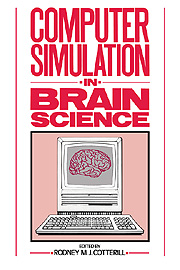Book contents
- Frontmatter
- Contents
- List of contributors
- Preface
- Neurons and neural networks: general principles
- Synaptic plasticity, topological and temporal features, and higher cortical processing
- Spin glass models and cellular automata
- Cyclic phenomena and chaos in neural networks
- The cerebellum and the hippocampus
- Olfaction, vision and cognition
- Applications to experiment, communication and control
- 32 Computer-aided design of neurobiological experiments
- 33 Simulation of the prolactin level fluctuations during pseudopregnancy in rats
- 34 Applications of biological intelligence to command, control and communications
- 35 Josin's computational system for use as a research tool
- Author index
- Subject index
34 - Applications of biological intelligence to command, control and communications
from Applications to experiment, communication and control
Published online by Cambridge University Press: 05 February 2012
- Frontmatter
- Contents
- List of contributors
- Preface
- Neurons and neural networks: general principles
- Synaptic plasticity, topological and temporal features, and higher cortical processing
- Spin glass models and cellular automata
- Cyclic phenomena and chaos in neural networks
- The cerebellum and the hippocampus
- Olfaction, vision and cognition
- Applications to experiment, communication and control
- 32 Computer-aided design of neurobiological experiments
- 33 Simulation of the prolactin level fluctuations during pseudopregnancy in rats
- 34 Applications of biological intelligence to command, control and communications
- 35 Josin's computational system for use as a research tool
- Author index
- Subject index
Summary
Introduction
It is quite evident that, while all sane people desire peace, all countries must practically provide for their self-defense. Thus, issues of procurement and implementation of combat systems must be objectively analyzed. When performing such analyses, it is useful and important to distinguish between specific combat components (‘anatomy’) and the Command, Control and Communications (C3) functions (‘physiology’) of these systems. If enormous financial and human resources must indeed be spent on a specific weapons system, then C3 models can offer procurement decision aids to spending these resources more efficiently. However, even before procuring specific weapon components, C3 models should be used to develop battle-management decision aids to help determine if it is feasible to consider building planned large-scale systems at all.
Even without agreement on just what C3 is, there is widespread criticism that we do not spend enough on C3 relative to what we spend on specific weapons systems (Blair, 1985). The Eastport Study Group (Eastport Study Group, 1985) has made this issue its primary concern with regard to the Strategic Defense Initiative (SDI) program. There is also an everpresent problem of weighing the political and military aspects between the hierarchical and distributed designs of C3, the former being politically desirable and appropriate for deterministic or modestly stochastic operations, and the latter being more appropriate for severely stochastic systems (Orr, 1983).
Information
- Type
- Chapter
- Information
- Computer Simulation in Brain Science , pp. 513 - 533Publisher: Cambridge University PressPrint publication year: 1988
Accessibility standard: Unknown
Why this information is here
This section outlines the accessibility features of this content - including support for screen readers, full keyboard navigation and high-contrast display options. This may not be relevant for you.Accessibility Information
- 2
- Cited by
